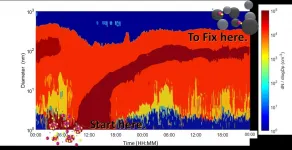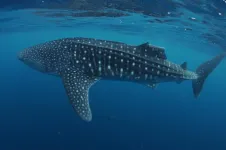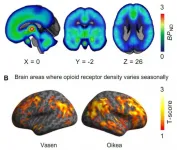(Press-News.org) According to recent estimates, there will be roughly 10 billion people to feed in 2050. Agricultural production will need to increase by almost 56% to guarantee food security globally, without converting more land for agriculture (in line with environmental and climate targets). This unprecedented challenge has ushered in the era of "smart agriculture," which promises to revolutionize food production by combining agricultural techniques with information technology, automation, and artificial intelligence. This new era, called "Agriculture 4.0," could ensure sustainable food production for the entire world. However, as communities gradually embrace smart agriculture, it is important to understand how to manage the security and privacy risks associated with the integration of information technology into agriculture.
To this end, in a new survey published in IEEE/CAA Journal of Automatica Sinica, researchers from China, Algeria, and the UK have performed a comprehensive analysis of the risks involved in current technologies used in smart agriculture and identified potential countermeasures. Lei Shu, a Professor from Nanjing Agricultural University in China and University of Lincoln in UK, the leading author of the paper, and Xing Yang from Nanjing Agricultural University in China, the first author of the paper, say, "Smart agriculture provides solutions for agricultural intelligence and automation. Both intellectual and unmanned operations are the development goals of smart agriculture."
The researchers also state that the field of smart agriculture is ripe with the risks of information theft and cyberattacks. To prevent these risks from putting global food supply in jeopardy, Yang and his team identified and proposed adequate countermeasures to the risks, based on the context (or "mode") of agricultural production. Commenting on their approach, Yang explains, "Security countermeasures based on urban conditions may not be suitable for rural conditions." They categorized the agricultural system into three modes: precision agriculture, facility agriculture, and order agriculture. Each of these modes has its own distinctive features (scale, climate, infrastructure, equipment, and technology) that makes it vulnerable to distinct types of risks requiring equally distinct countermeasures.
After laying this groundwork, the researchers set out to analyze the various security challenges involved in the three modes. First, they identified key technologies involved in each mode and their applications. The Internet of Things (IoT), which is arguably the most important technology in smart agriculture, is used in every mode, but has different applications depending on what specific tasks need to be performed. For instance, it is used in field agriculture to record environmental variables and analyze trends to predict optimal fertilizer input, while it can be used to automate environmental conditions in greenhouses and aquaculture. In each case, the way in which the technological architecture is set up exposes it to widely varying types of security challenges. For example, extreme environmental conditions can damage sensing equipment outside, while unauthorized access and malicious cyberattacks can compromise data integrity and site security, tamper with automated equipment, and lead to severe financial costs and a loss in food production. To better assess the solutions needed in each case, the researchers classified the challenges they identified as belonging either to agricultural production or information technology.
Reviewing each technology and their current applications, the researchers proposed six general countermeasures. These include technological solutions such as intrusion detection systems, authentication and access control, and privacy-preserving, blockchain-based solutions for data integrity, as well as physical countermeasures. Their study goes into great detail about how each solution can be applied in different contexts and how they address each of the challenges identified for smart agriculture.
After this comprehensive review, the scientists went one step further and pointed out that little is known about the potential security risks for agricultural equipment, such as sensors and tractors. They portray this lack of knowledge using a case study of one piece of equipment: a solar insecticidal lamp based on an IoT architecture (SIL-IoT). Their experiments showed that this lamp can cause electromagnetic interference and might even cause wireless sensor networks to malfunction. In this case, a simple physical separation distance was enough to address the security risk; however, the researchers advise caution.
As agriculture becomes more technologically complex, so will the challenges of ensuring its security. To this end, the researchers discussed other emerging technologies (such as 5G networks and VR/AR simulation) and the need for further research on their security impacts as their integration in smart agriculture becomes inevitable in the near future.
As we move towards a sustainable future with smart agriculture, let's also learn take a step back from time to time to check how we could become truly smart about it.
INFORMATION:
Reference
Authors
Xing Yang, Lei Shu, Jianing Chen, Mohamed Amine Ferrag, Jun Wu, Edmond Nurellari and Kai Huang
Title of original paper
A Survey on Smart Agriculture: Development Modes, Technologies, and Security and Privacy Challenges
Publication infor.
Vol. 8, Issue 2, 2021, IEEE/CAA JOURNAL OF AUTOMATICA SINICA
Link to Fulltext
http://www.ieee-jas.net/en/article/doi/10.1109/JAS.2020.1003536
https://ieeexplore.ieee.org/document/9269526
DOI 10.1109/JAS.2020.1003536
IEEE/CAA Journal of Automatica Sinica aims to publish high-quality, high-interest, far-reaching research achievements globally, and provide an international forum for the presentation of original ideas and recent results related to all aspects of automation.
The first Impact Factor of IEEE/CAA Journal of Automatica Sinica is 5.129, ranking among Top 17% (11/63, SCI Q1) in the category of Automation & Control Systems, according to the latest Journal Citation Reports released by Clarivate Analytics in 2020. In addition, its latest CiteScore is 8.3, and has entered Q1 in all three categories it belongs to (Information System, Control and Systems Engineering, Artificial Intelligence) since 2018.
Why publish with us: Fast and high quality peer review; Simple and effective online submission system; Widest possible global dissemination of your research; Indexed in SCIE, EI, IEEE, Scopus, Inspec.
JAS papers can be found at http://ieeexplore.ieee.org/xpl/mostRecentIssue.jsp?punumber=6570654 or http://www.ieee-jas.net
Washington, DC / New Delhi, India - Researchers at CDDEP, in collaboration with leading experts in the field, have produced the "Infectious Diseases in the South-East Asia Region" report, which examines cross-boundary challenges in communicable disease control in countries in the South-and South-East Asia region. The report emphasizes infectious diseases related to other sources of disease burden in the region and communicates overall trends in the health and economic burden they impose.
Despite substantial progress in recent years, which has seen reductions in deaths from HIV and malaria and an increase ...
Researchers of the University of Helsinki have resolved for the first time, how the ultrafine particles of atmosphere effect on the climate and health.
Atmospheric air pollution kills more than 10,000 people every day. The biggest threat to human health has been assumed to be the mass accumulation of atmospheric particles with diameter smaller 2.5 μm: the higher the mass and loss of visibility, the bigger the threat.
The researchers of the Institute for Atmospheric and Earth System Research (INAR) at the University of Helsinki together with collaborators in China discovered that if we want to solve the accumulation of the biggest particles, we need to start with the smallest.
Until recent ...
A new study has for the first time explored the rate at which the world's largest fish, the endangered whale shark, can recover from its injuries. The findings reveal that lacerations and abrasions, increasingly caused through collisions with boats, can heal in a matter of weeks and researchers found evidence of partially removed dorsal fins re-growing.
This work, published in the journal Conservation Physiology, comes at a critical time for these large sharks, that can reach lengths of up to 18 metres. Other recent studies have shown that as their popularity within the wildlife tourism sector increases, so do interactions with humans and boat traffic. As a result, these ...
Huntington's disease is caused by a mutation in the Huntingtin gene (HTT), which appears in adults and features motor, cognitive and psychiatric alterations. The origin of this disease has been associated with the anomalous functioning of the mutated protein: mHTT, but recent data showed the involvement of other molecular mechanisms.
A new study conducted by the University of Barcelona has identified a type of ribonucleic acid (RNA) as a potential therapeutic target for the treatment of the disease. These are the small RNA, or sRNAs, molecules that do not code proteins but have important functions in the regulation of gene expression. According to the study, sRNAs would ...
X-ray scans revolutionised medical treatments by allowing us to see inside humans without surgery. Similarly, terahertz spectroscopy penetrates graphene films allowing scientists to make detailed maps of their electrical quality, without damaging or contaminating the material. The Graphene Flagship brought together researchers from academia and industry to develop and mature this analytical technique, and now a novel measurement tool for graphene characterisation is ready.
The effort was possible thanks to the collaborative environment enabled by the Graphene Flagship European consortium, with participation by scientists from Graphene Flagship partners DTU, Denmark, IIT, Italy, Aalto University, Finland, AIXTRON, UK, imec, Belgium, Graphenea, Spain, Warsaw ...
Seasons have an impact on our emotions and social life. Negative emotions are more subdued in the summer, whereas seasonal affective disorder rates peak during the darker winter months. Opioids regulate both mood and sociability in the brain.
In the study conducted at the Turku PET Centre, Finland, researchers compared how the length of daylight hours affected the opioid receptors in humans and rats.
"In the study, we observed that the number of opioid receptors was dependent on the time of the year the brain was imaged. The changes were most prominent in the brain regions that control emotions and sociability. The changes in the opioid receptors caused by the variation in the amount of daylight could be an important factor in seasonal affective disorder," ...
WASHINGTON -- Researchers have developed a new sensor that could allow practical and low-cost detection of low concentrations of methane gas. Measuring methane emissions and leaks is important to a variety of industries because the gas contributes to global warming and air pollution.
"Agricultural and waste industries emit significant amounts of methane," said Mark Zondlo, leader of the Princeton University research team that developed the sensor. "Detecting methane leaks is also critical to the oil and gas industry for both environmental and economic reasons because natural gas is mainly composed of methane."
In ...
A new study suggests that a hormone known to prevent weight gain and normalize metabolism can also help maintain healthy muscles in mice. The findings present new possibilities for treating muscle-wasting conditions associated with age, obesity or cancer, according to scientists from the University of Southern California Leonard Davis School of Gerontology.
The research, published this month in the American Journal of Physiology-Endocrinology and Metabolism, addresses the related problems of age and obesity-induced muscle loss, conditions which can lead to increased risk of falls, diabetes and other negative health impacts. It also adds to a growing number of findings describing beneficial effects of MOTS-c, ...
Scientists at the University of Adelaide have challenged the common assumption that genetic diversity of a species is a key indicator of extinction risk.
Published in the journal PNAS, the scientists demonstrate that there is no simple relationship between genetic diversity and species survival. But, Dr Joao Teixeira and Dr Christian Huber from the University of Adelaide's School of Biological Sciences conclude, the focus shouldn't be on genetic diversity anyway, it should be on habitat protection.
"Nature is being destroyed by humans at a rate never seen before," says computational biologist Dr Huber. "We burn ...
COLUMBUS, Ohio - Scientists from around the world have published more than 87,000 papers about coronavirus between the start of the COVID-19 pandemic and October 2020, a new analysis shows.
Even given the importance of the pandemic, researchers were surprised by the huge number of studies and other papers that scientists produced on the subject in such a short time.
"It is an astonishing number of publications - it may be unprecedented in the history of science," said Caroline Wagner, co-author of the study and associate professor in the John Glenn College of Public Affairs at The Ohio State University.
"Nearly all of the scientific community around the world turned its attention to this one issue."
Wagner conducted the analysis with Xiaojing Cai from Zhejiang University in ...






